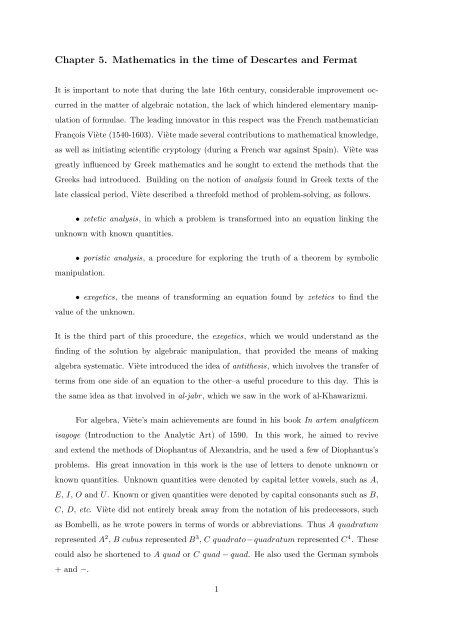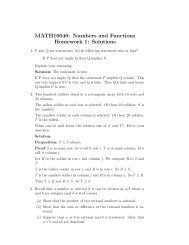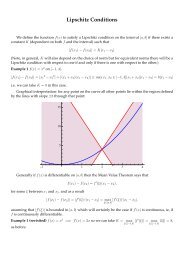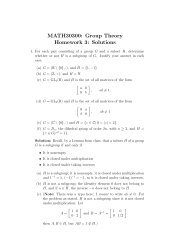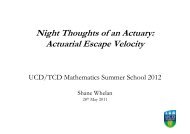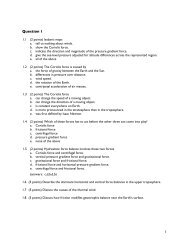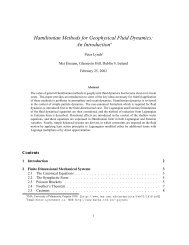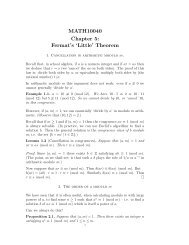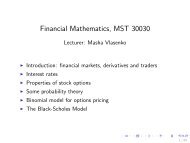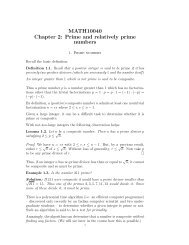Chapter 5. Mathematics in the time of Descartes and Fermat
Chapter 5. Mathematics in the time of Descartes and Fermat
Chapter 5. Mathematics in the time of Descartes and Fermat
Create successful ePaper yourself
Turn your PDF publications into a flip-book with our unique Google optimized e-Paper software.
<strong>Chapter</strong> <strong>5.</strong> <strong>Ma<strong>the</strong>matics</strong> <strong>in</strong> <strong>the</strong> <strong>time</strong> <strong>of</strong> <strong>Descartes</strong> <strong>and</strong> <strong>Fermat</strong>It is important to note that dur<strong>in</strong>g <strong>the</strong> late 16th century, considerable improvement occurred<strong>in</strong> <strong>the</strong> matter <strong>of</strong> algebraic notation, <strong>the</strong> lack <strong>of</strong> which h<strong>in</strong>dered elementary manipulation<strong>of</strong> formulae. The lead<strong>in</strong>g <strong>in</strong>novator <strong>in</strong> this respect was <strong>the</strong> French ma<strong>the</strong>maticianFrançois Viète (1540-1603). Viète made several contributions to ma<strong>the</strong>matical knowledge,as well as <strong>in</strong>itiat<strong>in</strong>g scientific cryptology (dur<strong>in</strong>g a French war aga<strong>in</strong>st Spa<strong>in</strong>). Viète wasgreatly <strong>in</strong>fluenced by Greek ma<strong>the</strong>matics <strong>and</strong> he sought to extend <strong>the</strong> methods that <strong>the</strong>Greeks had <strong>in</strong>troduced. Build<strong>in</strong>g on <strong>the</strong> notion <strong>of</strong> analysis found <strong>in</strong> Greek texts <strong>of</strong> <strong>the</strong>late classical period, Viète described a threefold method <strong>of</strong> problem-solv<strong>in</strong>g, as follows.• zetetic analysis, <strong>in</strong> which a problem is transformed <strong>in</strong>to an equation l<strong>in</strong>k<strong>in</strong>g <strong>the</strong>unknown with known quantities.• poristic analysis, a procedure for explor<strong>in</strong>g <strong>the</strong> truth <strong>of</strong> a <strong>the</strong>orem by symbolicmanipulation.• exegetics, <strong>the</strong> means <strong>of</strong> transform<strong>in</strong>g an equation found by zetetics to f<strong>in</strong>d <strong>the</strong>value <strong>of</strong> <strong>the</strong> unknown.It is <strong>the</strong> third part <strong>of</strong> this procedure, <strong>the</strong> exegetics, which we would underst<strong>and</strong> as <strong>the</strong>f<strong>in</strong>d<strong>in</strong>g <strong>of</strong> <strong>the</strong> solution by algebraic manipulation, that provided <strong>the</strong> means <strong>of</strong> mak<strong>in</strong>galgebra systematic. Viète <strong>in</strong>troduced <strong>the</strong> idea <strong>of</strong> anti<strong>the</strong>sis, which <strong>in</strong>volves <strong>the</strong> transfer <strong>of</strong>terms from one side <strong>of</strong> an equation to <strong>the</strong> o<strong>the</strong>r–a useful procedure to this day. This is<strong>the</strong> same idea as that <strong>in</strong>volved <strong>in</strong> al-jabr, which we saw <strong>in</strong> <strong>the</strong> work <strong>of</strong> al-Khawarizmi.For algebra, Viète’s ma<strong>in</strong> achievements are found <strong>in</strong> his book In artem analyticemisagoge (Introduction to <strong>the</strong> Analytic Art) <strong>of</strong> 1590. In this work, he aimed to revive<strong>and</strong> extend <strong>the</strong> methods <strong>of</strong> Diophantus <strong>of</strong> Alex<strong>and</strong>ria, <strong>and</strong> he used a few <strong>of</strong> Diophantus’sproblems. His great <strong>in</strong>novation <strong>in</strong> this work is <strong>the</strong> use <strong>of</strong> letters to denote unknown orknown quantities. Unknown quantities were denoted by capital letter vowels, such as A,E, I, O <strong>and</strong> U. Known or given quantities were denoted by capital consonants such as B,C, D, etc. Viète did not entirely break away from <strong>the</strong> notation <strong>of</strong> his predecessors, suchas Bombelli, as he wrote powers <strong>in</strong> terms <strong>of</strong> words or abbreviations. Thus A quadratumrepresented A 2 , B cubus represented B 3 , C quadrato−quadratum represented C 4 . Thesecould also be shortened to A quad or C quad − quad. He also used <strong>the</strong> German symbols+ <strong>and</strong> −.1
Divid<strong>in</strong>g we get,r 2 = − 4a 3 .Now our equation becomes s cos 3θ = −b <strong>and</strong> we deduce thatcos 3θ = − b s .We want to get real solutions for α <strong>and</strong> this requires that | cos 3θ| ≤ 1, or cos 2 3θ ≤ 1. We<strong>the</strong>refore must have b 2 − s 2 ≤ 0. ButThus we requires 2 = a2 r 29= − 4a327b 2 + 4a327 ≤ 0for this method to give real solutions, <strong>and</strong> this is precisely <strong>the</strong> condition that we haveassumed, <strong>and</strong> is <strong>the</strong> one that occurs <strong>in</strong> <strong>the</strong> irreducible case <strong>of</strong> <strong>the</strong> cubic. We can solve for3θ by tak<strong>in</strong>g <strong>in</strong>verse cos<strong>in</strong>es <strong>and</strong> <strong>the</strong>n divide by 3 to f<strong>in</strong>d θ. Then we evaluate cos θ <strong>and</strong> useα = r cos θ. At <strong>the</strong> <strong>time</strong> <strong>of</strong> Viète’s work, tables <strong>of</strong> cos<strong>in</strong>es were quite common for astronomical<strong>and</strong> navigational purposes <strong>and</strong> a solution <strong>of</strong> this k<strong>in</strong>d would have seemed perfectlycalculable. We see now that Viète’s solution provides an alternative (non-algebraic) solution<strong>in</strong> terms <strong>of</strong> real numbers precisely <strong>in</strong> <strong>the</strong> case that <strong>the</strong> algebraic solution by Cardano’smethod requires us to use complex numbers.One <strong>of</strong> <strong>the</strong> major advances <strong>in</strong> ma<strong>the</strong>matics <strong>of</strong> all <strong>time</strong> is <strong>the</strong> use <strong>of</strong> algebraic methodsto solve problems <strong>of</strong> pure geometry. This <strong>in</strong>novation was due to <strong>the</strong> French ma<strong>the</strong>matician<strong>and</strong> philosopher René <strong>Descartes</strong> (1596-1650). His work appeared <strong>in</strong> his publicationLa Géométrie, which was <strong>in</strong>cluded as an appendix to his famous philosophical treatiseDiscours de la méthode (1637). Interest<strong>in</strong>gly, despite its scholarly nature, it was written<strong>in</strong> French, ra<strong>the</strong>r than <strong>the</strong> more erudite Lat<strong>in</strong>. <strong>Descartes</strong>’s notation <strong>in</strong> this work is recognizablysimilar to our own, <strong>in</strong> marked dist<strong>in</strong>ction to that used by <strong>the</strong> Italians a centuryor even fifty years earlier. He employed <strong>the</strong> + <strong>and</strong> − signs, adopted from German arithmetictexts <strong>of</strong> <strong>the</strong> 16th centuries. He used exponential notation such as y 3 for powers <strong>of</strong>unknowns, <strong>and</strong> surd signs for square roots. Variables are usually denoted by small romanletters from <strong>the</strong> end <strong>of</strong> <strong>the</strong> alphabet, <strong>and</strong> constant quantities by small roman letters from<strong>the</strong> beg<strong>in</strong>n<strong>in</strong>g <strong>of</strong> <strong>the</strong> alphabet, such as a, b, c. Here aga<strong>in</strong>, this is <strong>the</strong> convention frequentlyadopted today. The only major difference is that he did not adopt <strong>the</strong> = sign for equality,but used <strong>in</strong>stead a sign similar to one used to denote proportionality. He also, when multiply<strong>in</strong>ga symbol such as y or y 2 by an algebraic expression such as a 2 +ab+b 2 , might write3
served on various <strong>of</strong>ficial bodies. His real <strong>in</strong>terest was ma<strong>the</strong>matics, which he studied <strong>in</strong>his spare <strong>time</strong>.Unlike most noteworthy French ma<strong>the</strong>maticians, <strong>Fermat</strong> never lived <strong>in</strong> Paris. Hecorresponded with lead<strong>in</strong>g French ma<strong>the</strong>maticians, <strong>in</strong>clud<strong>in</strong>g Pascal <strong>and</strong> Mersenne. <strong>Fermat</strong>never published any <strong>of</strong> his discoveries. For this reason, we do not usually know hiswork<strong>in</strong>g methods <strong>and</strong> cannot always be sure that facts he claimed as true were actuallyproved or merely conjectured. He certa<strong>in</strong>ly had numerous good ideas, <strong>and</strong> would droph<strong>in</strong>ts to his correspondents <strong>of</strong> how he had proceeded to prove th<strong>in</strong>gs. His son published<strong>Fermat</strong>’s manuscripts <strong>in</strong> 1679, <strong>and</strong> <strong>the</strong>se provide us with most <strong>of</strong> our <strong>in</strong>formation abouthis methods.<strong>Fermat</strong>’s <strong>in</strong>terests span a wide range <strong>of</strong> ma<strong>the</strong>matical activity. He is known forhis work on <strong>the</strong> beg<strong>in</strong>n<strong>in</strong>gs <strong>of</strong> probability <strong>the</strong>ory, partly <strong>in</strong> response to questions raised byPascal. (It might be worth remark<strong>in</strong>g that Cardano had made some earlier observations onelementary probability <strong>the</strong>ory <strong>in</strong> <strong>the</strong> previous century.) He is also recognized for <strong>Fermat</strong>’spr<strong>in</strong>ciple <strong>in</strong> physics. This pr<strong>in</strong>ciple states that light travels <strong>in</strong> such a way as to m<strong>in</strong>imize<strong>the</strong> <strong>time</strong> taken to pass between two given po<strong>in</strong>ts. As light travels at different speeds <strong>in</strong>different media, for example, <strong>in</strong> air <strong>and</strong> <strong>in</strong> glass, it is possible to expla<strong>in</strong> <strong>the</strong> observed laws<strong>of</strong> reflection <strong>and</strong> refraction by this pr<strong>in</strong>ciple.Along with <strong>Descartes</strong>, <strong>Fermat</strong> is held to be one <strong>of</strong> <strong>the</strong> creators <strong>of</strong> modern analyticgeometry. He was <strong>in</strong>fluenced by Viète’s use <strong>of</strong> algebraic symbols <strong>and</strong> tried to apply algebrato study <strong>the</strong> work <strong>of</strong> Apollonius on geometric loci, such as conic sections. He was ableto relate <strong>the</strong> conic sections to what we now call equations <strong>of</strong> <strong>the</strong> second degree, such asx 2 − y 2 = 1 or x 2 = y. Before <strong>the</strong> development <strong>of</strong> <strong>the</strong> differential calculus later <strong>in</strong> <strong>the</strong>17th century, <strong>Fermat</strong> is credited with techniques for f<strong>in</strong>d<strong>in</strong>g local maximum <strong>and</strong> m<strong>in</strong>imumvalues on curves.It is for his work on number <strong>the</strong>ory that <strong>Fermat</strong> is best remembered. Gauss held that,although <strong>the</strong> Arithmetica <strong>of</strong> Diophantus displayed great skill, it consisted <strong>of</strong> solutions toisolated problems which did not constitute a <strong>the</strong>ory. It was only <strong>in</strong> <strong>the</strong> 17th century thataproper <strong>the</strong>ory <strong>of</strong> numbers emerged, beg<strong>in</strong>n<strong>in</strong>g with <strong>the</strong> work <strong>of</strong> <strong>Fermat</strong>, <strong>and</strong> cont<strong>in</strong>ued<strong>in</strong> <strong>the</strong> 18th century by Euler, Lagrange <strong>and</strong> Legendre. Gauss himself provided <strong>the</strong> mostcomplete work on number <strong>the</strong>ory, his Disquisitiones arithmeticae, published <strong>in</strong> 1801 whenhe was only 24, <strong>in</strong> which he described <strong>the</strong> work <strong>of</strong> his predecessors <strong>and</strong> found numerous5
new l<strong>in</strong>es <strong>of</strong> research.One popular <strong>the</strong>me <strong>in</strong> number <strong>the</strong>ory has been that <strong>of</strong> sums <strong>of</strong> squares.<strong>in</strong>tegers can be written <strong>in</strong> <strong>the</strong> formx 2 + y 2 ,Whatwhere x <strong>and</strong> y are <strong>in</strong>tegers, or <strong>in</strong> <strong>the</strong> formx 2 + y 2 + z 2 ,where x, y <strong>and</strong> z are <strong>in</strong>tegers, <strong>and</strong> so on. Bachet (who translated <strong>the</strong> Arithmetica <strong>of</strong>Diophantus <strong>in</strong>to Lat<strong>in</strong> <strong>in</strong> 1621, a translation much used by <strong>Fermat</strong>) conjectured thatevery <strong>in</strong>teger n is a sum <strong>of</strong> four squares,n = x 2 + y 2 + z 2 + w 2 ,where x, y, z <strong>and</strong> w are <strong>in</strong>tegers. This was eventually rigorously proved by Lagrange<strong>in</strong> 1770’s. <strong>Fermat</strong>, <strong>in</strong> a letter to Mersenne <strong>in</strong> 1640, asserted that any prime p satisfy<strong>in</strong>gp ≡ 1 mod 4 can be written asp = a 2 + b 2 ,for suitable <strong>in</strong>tegers a <strong>and</strong> b. If we assume that 0 < a < b, <strong>the</strong>n a <strong>and</strong> b are unique. Exactdetails <strong>of</strong> his pro<strong>of</strong> are not available but he claimed to use his method <strong>of</strong> <strong>in</strong>f<strong>in</strong>ite descent,which is a powerful method that may be applied to certa<strong>in</strong> Diophant<strong>in</strong>e equations. It is asort <strong>of</strong> <strong>in</strong>duction <strong>in</strong> reverse. He probably used <strong>the</strong> technique <strong>in</strong> his study <strong>of</strong> <strong>the</strong> so-called<strong>Fermat</strong> problems, such as show<strong>in</strong>g that <strong>the</strong>re are no solutions to <strong>the</strong> equationx 3 + y 3 = z 3 ,where x, y <strong>and</strong> z are all non-zero <strong>in</strong>tegers. He certa<strong>in</strong>ly showed that <strong>the</strong>re are no non-trivial<strong>in</strong>teger solutions to <strong>the</strong> equationx 4 + y 4 = z 4 ,us<strong>in</strong>g his method <strong>of</strong> <strong>in</strong>f<strong>in</strong>ite descent.His success <strong>in</strong> show<strong>in</strong>g <strong>the</strong> non-existence <strong>of</strong> non-trivial <strong>in</strong>tegral solutions to <strong>the</strong>seDiophant<strong>in</strong>e equations must have led <strong>Fermat</strong> to believe that <strong>the</strong> method <strong>of</strong> descent couldlikewise prove that <strong>the</strong>re are no non-zero <strong>in</strong>tegers x, y <strong>and</strong> z that satisfyx n + y n = z n ,6
whenever n is an <strong>in</strong>teger greater than 2. He certa<strong>in</strong>ly left a note <strong>in</strong> <strong>the</strong> marg<strong>in</strong> <strong>of</strong> his copy<strong>of</strong> <strong>the</strong> Arithmetica stat<strong>in</strong>g that he had found such a solution. This assertion achieved<strong>in</strong>ternational prom<strong>in</strong>ence with <strong>the</strong> publication <strong>of</strong> <strong>Fermat</strong>’s collected works <strong>in</strong> 1679, whichbrought <strong>Fermat</strong>’s claim out <strong>in</strong>to <strong>the</strong> open. Nobody was able to make <strong>the</strong> method <strong>of</strong> descentapply <strong>in</strong> <strong>the</strong> cases where n > 4, <strong>and</strong> we must presume that <strong>Fermat</strong> was wrong <strong>in</strong> his claim.In fact, attempts to verify <strong>the</strong> truth <strong>of</strong> <strong>Fermat</strong>’s Last Theorem (as <strong>the</strong> problem becameknown) led to <strong>the</strong> development <strong>of</strong> a vast generalization <strong>of</strong> arithmetic known as algebraicnumber <strong>the</strong>ory, <strong>in</strong> which <strong>the</strong> <strong>the</strong>ory <strong>of</strong> primes <strong>and</strong> unique factorization is carried over tocerta<strong>in</strong> special types <strong>of</strong> complex number. Even this was not enough to prove <strong>Fermat</strong>’sLast Theorem <strong>in</strong> general, as <strong>the</strong> complete pro<strong>of</strong> by Andrew Wiles <strong>in</strong> 1995 used techniques<strong>of</strong> algebraic geometry <strong>and</strong> modular form <strong>the</strong>ory.<strong>Fermat</strong> considered fur<strong>the</strong>r problems concern<strong>in</strong>g primes.that every prime p satisfy<strong>in</strong>g p ≡ 1 mod 3 is expressible asFor example, he claimedp = a 2 + 3b 2for suitable <strong>in</strong>tegers a <strong>and</strong> b (letter to Pascal, 1654). All <strong>of</strong> <strong>Fermat</strong>’s claims are true,<strong>and</strong> he may well have proved <strong>the</strong>m. However, def<strong>in</strong>itive pro<strong>of</strong>s first appeared with Euler,<strong>and</strong> Gauss provided <strong>the</strong> most satisfactory approach to problems <strong>of</strong> <strong>the</strong> k<strong>in</strong>d considered by<strong>Fermat</strong>.We will now discuss some <strong>of</strong> <strong>Fermat</strong>’s work relat<strong>in</strong>g to primes. The Greeks had<strong>in</strong>vestigated properties <strong>of</strong> <strong>in</strong>tegers <strong>and</strong> Euclid’s Elements <strong>in</strong>cludes an account <strong>of</strong> what<strong>the</strong>y had discovered. Greek ma<strong>the</strong>maticians had a particular <strong>in</strong>terest <strong>in</strong> perfect numbers.An <strong>in</strong>teger n > 1 is said to be perfect if <strong>the</strong> sum <strong>of</strong> all its positive <strong>in</strong>teger divisors, <strong>in</strong>clud<strong>in</strong>g1 but exclud<strong>in</strong>g n itself, equals n. Thus, for example, 6 is perfect as its divisors less than6 are 1, 2 <strong>and</strong> 3 <strong>and</strong>1 + 2 + 3 = 6.Similarly, 28 is perfect, as its divisors are 1, 2, 4, 7 <strong>and</strong> 14, whose sum is 28.A means <strong>of</strong> produc<strong>in</strong>g even perfect numbers is described <strong>in</strong> Euclid’s Elements <strong>in</strong> <strong>the</strong>follow<strong>in</strong>g way. Suppose that for some positive <strong>in</strong>teger m, 2 m − 1 is a prime. Then <strong>the</strong><strong>in</strong>teger 2 m−1 (2 m − 1) is perfect. For, if we set 2 m − 1 = p, where p is a prime, it is easyto see that <strong>the</strong> divisors <strong>of</strong> n = 2 m−1 p are1, 2, 2 2 , · · · , 2 m−1 , p, 2p, · · · , 2 m−2 p.7
Now1 + 2 + 2 2 + · · · + 2 m−1 = 2 m − 1 = p<strong>and</strong>p + 2p + · · · + 2 m−2 p = (2 m−1 − 1)pby <strong>the</strong> formula for summ<strong>in</strong>g a geometric progression. Thus it is clear that <strong>the</strong> sum <strong>of</strong> <strong>the</strong>divisors <strong>of</strong> n is n <strong>in</strong> this case. We obta<strong>in</strong> <strong>the</strong> perfect numbers 6 by tak<strong>in</strong>g m = 2 <strong>and</strong> 28by tak<strong>in</strong>g m = 3. The next perfect number obta<strong>in</strong>ed is 2 4 · 31 = 496, when m = <strong>5.</strong>Primes <strong>of</strong> <strong>the</strong> form 2 m − 1 have become known as Mersenne primes, after <strong>the</strong> 17thcentury French ma<strong>the</strong>matician <strong>and</strong> priest Mar<strong>in</strong> Mersenne. Mersenne primes play a specialrole <strong>in</strong> various parts <strong>of</strong> ma<strong>the</strong>matics, especially group <strong>the</strong>ory <strong>and</strong> number <strong>the</strong>ory. In1732, <strong>the</strong> Swiss ma<strong>the</strong>matician Leonhard Euler proved that any even perfect number isnecessarily one <strong>of</strong> <strong>the</strong> type described by Euclid (<strong>of</strong> <strong>the</strong> form 2 m−1 (2 m − 1), with 2 m − 1a prime). To this day, no example <strong>of</strong> an odd perfect number has been found <strong>and</strong> <strong>the</strong>yare conjectured not to exist. However, attempts to prove that <strong>the</strong>re are no odd perfectnumbers have been unsuccessful.<strong>Fermat</strong> observed that, if 2 m − 1 is a prime, <strong>the</strong>n m must itself be a prime. For if mis composite, say m = rs, where r <strong>and</strong> s are <strong>in</strong>tegers with 1 < r < m, 1 < s < m, <strong>the</strong>n2 r − 1 divides 2 m − 1, s<strong>in</strong>ce2 m − 1 = 2 rs − 1 = (2 r − 1)(2 (r−1)s + 2 (r−2)s + · · · + 2 s + 1).Thus 2 m − 1 can only be a prime if m is a prime, say m = p. We should note that notevery number <strong>of</strong> <strong>the</strong> form 2 p − 1, where p is a prime, is itself a prime. Never<strong>the</strong>less, wecall any number <strong>of</strong> <strong>the</strong> form 2 p − 1, where p is a prime, a Mersenne number. The smallestMersenne number that is not a prime is 2 11 − 1 = 23 × 89. To <strong>in</strong>vestigate possible factors<strong>of</strong> Mersenne numbers, <strong>Fermat</strong> proved an important result, which has become known as<strong>Fermat</strong>’s Little Theorem. We can formulate this <strong>the</strong>orem as follows. Let r be a prime <strong>and</strong>let c be an <strong>in</strong>teger not divisible by r. Then c r−1 ≡ 1 mod r, or <strong>in</strong> o<strong>the</strong>r words, r divides2 r−1 −1. Now let l be <strong>the</strong> smallest positive <strong>in</strong>teger such that r divides c l −1. Then <strong>Fermat</strong>showed that l divides r − 1. We call l <strong>the</strong> order <strong>of</strong> c modulo r.Suppose now that p is a prime <strong>and</strong> r is a prime divisor <strong>of</strong> <strong>the</strong> Mersenne number2 p − 1. It is straightforward to see that p is <strong>the</strong> order <strong>of</strong> 2 modulo r <strong>and</strong> thus p dividesr − 1 by <strong>Fermat</strong>’s result. It follows that r − 1 = tp for some <strong>in</strong>teger t <strong>and</strong> thus r = 1 + tp.8
Us<strong>in</strong>g this result, it is easy to see that 23 = 1 + 2 · 11 might be a divisor <strong>of</strong> 2 11 − 1 <strong>and</strong> thisproves to be <strong>the</strong> case. <strong>Fermat</strong> was led to discover <strong>the</strong> prime divisor 223 = 1 + 6 · 37 <strong>of</strong> <strong>the</strong>Mersenne number 2 37 − 1. Use <strong>of</strong> <strong>Fermat</strong>’s <strong>the</strong>orem makes it easier to search for possibleprime divisors <strong>of</strong> Mersenne numbers. While many Mersenne numbers have proved not tobe primes, several are primes. Indeed, many <strong>of</strong> <strong>the</strong> largest known primes are Mersenneprimes. For example, 2 127 −1 was shown to be a prime <strong>in</strong> 1876 <strong>and</strong> it rema<strong>in</strong>ed <strong>the</strong> largestknown prime until 1951 (at <strong>the</strong> beg<strong>in</strong>n<strong>in</strong>g <strong>of</strong> <strong>the</strong> era <strong>of</strong> high-speed comput<strong>in</strong>g mach<strong>in</strong>es).The Mersenne number 2 216091 −1, which is a 65, 050 digit <strong>in</strong>teger, was shown to be a prime<strong>in</strong> 198<strong>5.</strong> It took 3 hours <strong>of</strong> comput<strong>in</strong>g <strong>time</strong> with a Cray computer to prove <strong>the</strong> primality<strong>of</strong> <strong>the</strong> number. Several special tests are available to determ<strong>in</strong>e whe<strong>the</strong>r Mersenne numbersare prime, <strong>and</strong> this accounts for <strong>the</strong> occurrence <strong>of</strong> many Mersenne primes <strong>in</strong> <strong>the</strong> lists <strong>of</strong>large prime numbers.<strong>Fermat</strong> also <strong>in</strong>vestigated whe<strong>the</strong>r a number <strong>of</strong> <strong>the</strong> form 2 m + 1 might be a prime. Itis not hard to see that such a number cannot be a prime if m has an odd divisor biggerthan 1. Therefore, such a number can only be a prime if m is a power <strong>of</strong> 2, say m = 2 k .<strong>Fermat</strong> actually conjectured that when m = 2 k , <strong>the</strong> number F k def<strong>in</strong>ed byF k = 2 2k + 1is a prime. This is certa<strong>in</strong>ly true when k = 0, 1, 2, 3 or 4. However, <strong>Fermat</strong>’s conjectureseems to be spectacularly <strong>in</strong>correct, as no value <strong>of</strong> k bigger than 4 has been found forwhich F k is a prime. In 1732, Euler found <strong>the</strong> factorizationF 5 = 2 32 + 1 = 641 × 6700417.S<strong>in</strong>ce Euler’s factorization <strong>of</strong> F 5 , several o<strong>the</strong>r numbers <strong>of</strong> <strong>the</strong> form F k have been factorized,while o<strong>the</strong>rs have been proved to be composite without explicit factorizations be<strong>in</strong>g found.The numbers F k are called <strong>Fermat</strong> numbers. So far, only five <strong>Fermat</strong> numbers have provedto be primes <strong>and</strong> it is even conjectured that <strong>the</strong>re are no <strong>Fermat</strong> numbers F k that areprime for k ≥ <strong>5.</strong> Of course, F k is an enormously large number if k is at all large <strong>and</strong> sodirect factorization is rarely feasible. Those <strong>Fermat</strong> numbers that are primes are called<strong>Fermat</strong> primes. Like <strong>the</strong> Mersenne primes, <strong>the</strong> <strong>Fermat</strong> primes still have an importantposition <strong>in</strong> ma<strong>the</strong>matics.Surpris<strong>in</strong>gly, <strong>Fermat</strong> primes emerged <strong>in</strong> a piece <strong>of</strong> geometric research conducted morethan one century after <strong>Fermat</strong>’s death. The German ma<strong>the</strong>matician Carl Friedrich Gauss9
(1777-1855) is known as one <strong>of</strong> <strong>the</strong> greatest ma<strong>the</strong>maticians <strong>of</strong> all <strong>time</strong>. His early famerests on his book Disquisitiones arithmeticae, published <strong>in</strong> 1801 when he was just 24. Thebook conta<strong>in</strong>s all <strong>the</strong> work on number <strong>the</strong>ory that he had done up to that <strong>time</strong>. It <strong>in</strong>cludes<strong>the</strong> def<strong>in</strong>itive result on <strong>the</strong> construction <strong>of</strong> regular polygons us<strong>in</strong>g ruler <strong>and</strong> compass alone.It had been known s<strong>in</strong>ce <strong>the</strong> <strong>time</strong> <strong>of</strong> Euclid <strong>and</strong> earlier that we can construct a regular(equilateral) triangle, a regular pentagon, a regular hexagon, <strong>and</strong> any regular polygonhav<strong>in</strong>g 2 n sides, us<strong>in</strong>g a ruler <strong>and</strong> compass alone. No fur<strong>the</strong>r constructions <strong>of</strong> such figureswere known. Us<strong>in</strong>g his work on <strong>the</strong> roots <strong>of</strong> <strong>the</strong> polynomial x n −1 (which are <strong>of</strong> course <strong>the</strong>complex roots <strong>of</strong> unity cos(2kπ/n)+i s<strong>in</strong>(2kπ/n)), Gauss proved <strong>the</strong> follow<strong>in</strong>g fundamentalresult:• Let p be a prime number. A regular polygon <strong>of</strong> p sides is constructible by ruler <strong>and</strong>compass alone if <strong>and</strong> only if p is a <strong>Fermat</strong> prime. A regular polygon <strong>of</strong> n sides isconstructible by ruler <strong>and</strong> compass alone if <strong>and</strong> only if, <strong>in</strong> <strong>the</strong> prime factorization <strong>of</strong>n, we have n = 2 t p 1 p 2 · · · p r , where p 1 , . . . , p r are different <strong>Fermat</strong> primes.It is said that Gauss’s discovery <strong>of</strong> <strong>the</strong> construction by ruler <strong>and</strong> compass <strong>of</strong> <strong>the</strong> regular17-sided polygon <strong>in</strong> 1796, when he was only 18, was <strong>the</strong> crucial event that decided him onhis career as a ma<strong>the</strong>matician <strong>and</strong> not as a philologist. The actual construction is a littletechnical but Gauss’s work is considered to be <strong>the</strong> most orig<strong>in</strong>al addition to <strong>the</strong> study <strong>of</strong>Euclidian geometry for over two thous<strong>and</strong> years.His success <strong>in</strong> show<strong>in</strong>g <strong>the</strong> non-existence <strong>of</strong> non-trivial <strong>in</strong>tegral solutions to <strong>the</strong>seDiophant<strong>in</strong>e equations must have led <strong>Fermat</strong> to believe that <strong>the</strong> method <strong>of</strong> descent couldlikewise prove that <strong>the</strong>re are no non-zero <strong>in</strong>tegers x, y <strong>and</strong> z that satisfyx n + y n = z n ,whenever n is an <strong>in</strong>teger greater than 2. He certa<strong>in</strong>ly left a note <strong>in</strong> <strong>the</strong> marg<strong>in</strong> <strong>of</strong> his copy<strong>of</strong> <strong>the</strong> Arithmetica stat<strong>in</strong>g that he had found such a solution. Nobody was able to make<strong>the</strong> method <strong>of</strong> descent apply <strong>in</strong> <strong>the</strong> cases where n > 4, <strong>and</strong> we must presume that <strong>Fermat</strong>was wrong <strong>in</strong> his claim. In fact, attempts to verify <strong>the</strong> truth <strong>of</strong> <strong>Fermat</strong>’s Last Theorem(as <strong>the</strong> claim became known) led to <strong>the</strong> development <strong>of</strong> a vast generalization <strong>of</strong> arithmeticknown as algebraic number <strong>the</strong>ory, <strong>in</strong> which <strong>the</strong> <strong>the</strong>ory <strong>of</strong> primes <strong>and</strong> unique factorizationis carried over to certa<strong>in</strong> special types <strong>of</strong> complex number. Even this was not enough toprove <strong>Fermat</strong>’s Last Theorem <strong>in</strong> general, as <strong>the</strong> complete pro<strong>of</strong> by Andrew Wiles <strong>in</strong> 1995used techniques <strong>of</strong> algebraic geometry <strong>and</strong> modular form <strong>the</strong>ory.10


